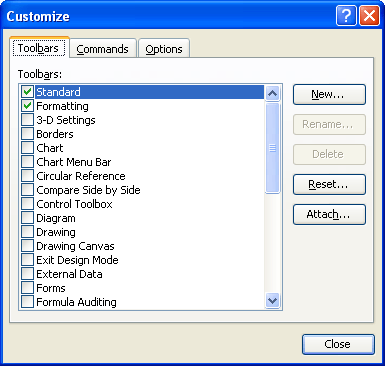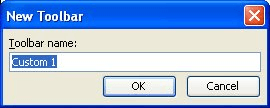Written by Allen Wyatt (last updated April 22, 2023)
This tip applies to Excel 97, 2000, 2002, and 2003
As you are customizing Excel to reflect your working habits, there may be times when you want to create your own custom toolbar. You can create a toolbar by following these steps:

Figure 1. The Toolbars tab of the Customize dialog box.

Figure 2. The New Toolbar dialog box.

Figure 3. The Commands tab of the Customize dialog box.
ExcelTips is your source for cost-effective Microsoft Excel training. This tip (2722) applies to Microsoft Excel 97, 2000, 2002, and 2003.

Create Custom Apps with VBA! Discover how to extend the capabilities of Office 365 applications with VBA programming. Written in clear terms and understandable language, the book includes systematic tutorials and contains both intermediate and advanced content for experienced VB developers. Designed to be comprehensive, the book addresses not just one Office application, but the entire Office suite. Check out Mastering VBA for Microsoft Office 365 today!
Do you wish that the buttons on your Excel toolbars were easier to see and use? The answer could be to turn on the large ...
Discover MoreDon't like the toolbar button images in your version of Excel? Don't fret; you can pull up the button editor and make ...
Discover MoreIf your Formula bar disappears when you load a workbook, it could be due to the presence of a macro that turns it off. ...
Discover MoreFREE SERVICE: Get tips like this every week in ExcelTips, a free productivity newsletter. Enter your address and click "Subscribe."
There are currently no comments for this tip. (Be the first to leave your comment—just use the simple form above!)
Got a version of Excel that uses the menu interface (Excel 97, Excel 2000, Excel 2002, or Excel 2003)? This site is for you! If you use a later version of Excel, visit our ExcelTips site focusing on the ribbon interface.
FREE SERVICE: Get tips like this every week in ExcelTips, a free productivity newsletter. Enter your address and click "Subscribe."
Copyright © 2026 Sharon Parq Associates, Inc.
Comments